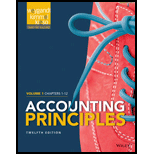
Inventory Turnover: It is a part of efficiency ratios used during the process of ratio analysis. It reflects the number of times a company’s inventory is converted into sale during a particular period. The cost of goods sold is divided by average inventory to get the value of inventory turnover.
Profit Margin: Profit margin reflects the portion of net income in the net sales. It is a profitability measure tool that is used to evaluate the net income a business earns on every dollar of net sales. It is computed as net income divided by net revenue.
Return on Total Assets: It is a measure to evaluate the efficiency of company’s assets. It reports the profit earned as the percentage of total assets used in the business. A company’s
Rate of Return on Common
Debt to Assets Ratio: It is the ratio between total assets of the company and the total liabilities. Debt ratio reflects the finance strategy of the company. It is used to evaluate company’s ability to pay its debts. Higher debt ratio implies the higher financial risk.
Times Interest Earned Ratio: It’s a measure to evaluate the net income for interest payment on debt of a company. It is a part of solvency ratios.
To compute: (a) Current ratio (b) Inventory turnover (c) Profit margin (d) Return on assets (e) Return on common stockholders’ equity (f) Debt to assets ratio (g) Times interest earned ratios of M Company for 2016 and 2017.
Want to see the full answer?
Check out a sample textbook solution
Chapter 18 Solutions
ACCOUNTING PRINCIPLES V.1 W/ WILEY PLU
- Bansai, age 66, retires and receives a $1,450 per month annuity from his employer's qualified pension plan. Bansai made $87,600 of after-tax contributions to the plan before retirement. Under the simplified method, Bansai's number of anticipated payments is 240. What is the amount includible in income in the first year of withdrawals assuming 12 monthly payments? A. $10,560 B. $12,540 C. $17,400 D. $8,220arrow_forwardWhat is the cost of goods sold?arrow_forwardCan you help me find the accurate solution to this financial accounting problem using valid principles?arrow_forward
- Please provide the solution to this general accounting question using proper accounting principles.arrow_forwardI am looking for help with this general accounting question using proper accounting standards.arrow_forwardCan you demonstrate the accurate method for solving this General accounting question?arrow_forward

 AccountingAccountingISBN:9781337272094Author:WARREN, Carl S., Reeve, James M., Duchac, Jonathan E.Publisher:Cengage Learning,
AccountingAccountingISBN:9781337272094Author:WARREN, Carl S., Reeve, James M., Duchac, Jonathan E.Publisher:Cengage Learning, Accounting Information SystemsAccountingISBN:9781337619202Author:Hall, James A.Publisher:Cengage Learning,
Accounting Information SystemsAccountingISBN:9781337619202Author:Hall, James A.Publisher:Cengage Learning, Horngren's Cost Accounting: A Managerial Emphasis...AccountingISBN:9780134475585Author:Srikant M. Datar, Madhav V. RajanPublisher:PEARSON
Horngren's Cost Accounting: A Managerial Emphasis...AccountingISBN:9780134475585Author:Srikant M. Datar, Madhav V. RajanPublisher:PEARSON Intermediate AccountingAccountingISBN:9781259722660Author:J. David Spiceland, Mark W. Nelson, Wayne M ThomasPublisher:McGraw-Hill Education
Intermediate AccountingAccountingISBN:9781259722660Author:J. David Spiceland, Mark W. Nelson, Wayne M ThomasPublisher:McGraw-Hill Education Financial and Managerial AccountingAccountingISBN:9781259726705Author:John J Wild, Ken W. Shaw, Barbara Chiappetta Fundamental Accounting PrinciplesPublisher:McGraw-Hill Education
Financial and Managerial AccountingAccountingISBN:9781259726705Author:John J Wild, Ken W. Shaw, Barbara Chiappetta Fundamental Accounting PrinciplesPublisher:McGraw-Hill Education





